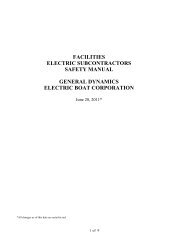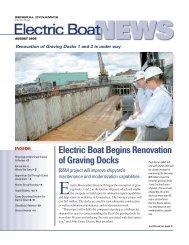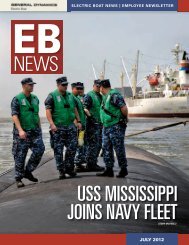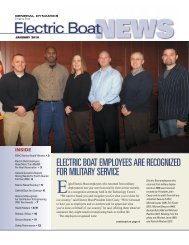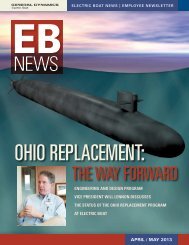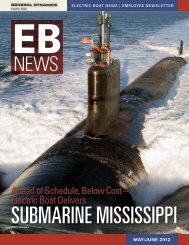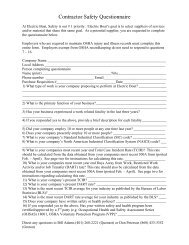EB news mar 04 - Electric Boat
EB news mar 04 - Electric Boat
EB news mar 04 - Electric Boat
You also want an ePaper? Increase the reach of your titles
YUMPU automatically turns print PDFs into web optimized ePapers that Google loves.
OCTOBER 2009<br />
<strong>EB</strong> SALUTES NEWEST GROUP OF DISTINGUISHED SHIPBUILDERS<br />
Eighty six employees with 40 years of service at <strong>Electric</strong> <strong>Boat</strong> joined the ranks of Distinguished Shipbuilders earlier this month at a banquet held to recognize their contributions<br />
to the company and the nation’s defense. In the top photo are, bottom row from left, Paul Havener Jr., John Holt, Alan Clarke, Raymond Mitchell, Robert Calabro,<br />
Jordan Correia, Hector Morales, Donald Manzi, William Owens and Richard Ryan In the second row are Richard Bradford, Roger Hary, Robert Valentine, Edward Luther,<br />
Herve Brouillette, Edward Faubert Sr., Samual Holdridge, Charles Sprague, James Lewis, Charles DeLauro, Michael DeNoia and Ronald Arruda. In the top row are Daniel<br />
Castano, Frederick Butts, Allan Stanton, Carl Kieburg Jr., Thomas Janus, John Sior, William McDonald, Thomas Kirk, Roy Ditmore, Edward Handy, Ernest Lewis III and John<br />
Neilan. In the bottom photo are, bottom row from left, Robert Lambert, David Collins, Raymond Coon Sr., Robert Piccaro, Ernestine Clark, Nancy Cramer, Thomas Stankiewicz,<br />
Lawrence Gavitt, Nicholas Stimac and William DeFosses. In the second row are John Lavigne, Gerald Heon, Anthony Granata, James Fonk, Dana Allen Sr., Theron Tefft,<br />
Steven Giesing, Richard Algiere, Charles Hedding and Gordon Rose. In the top row are Theodore Richards, James Rogers, Ernest Vacca Jr., Keith Gould, Edward Card,<br />
Steven Picard, John Kennedy III and Arnold Mohring. Honorees not in photographs are Donald Allen, James Arza<strong>mar</strong>ski, Gregory Ayson, Paul Boudreau, Phillip Brown,<br />
Richard Clark Jr., Philip Clark, Samuel DeCoste III, Thomas Dumais Jr., Robert Frink, George Gregory Jr., Russell Harrington, Raymond Howard, Robert Kubera, James<br />
La<strong>mar</strong>re Jr., Efrain Mendez, Joseph Papalia, Richard Roach, Clifford Shippee, Thomas Sliney Jr., Gilbert Suarez, Tommy Vickers, Alexander Vollaro and Robert White.
Gathering for a Navy award recognizing their contributions to safety at the Groton sub<strong>mar</strong>ine<br />
base are Art Delmage (246) – safety committee representative/Pipe and Lag Shops; Ken O'Brien<br />
(645) – off-site safety representative; Mark Caise (795) – sheet metal shop foreman; Joe Papalia<br />
(795) – production supervisor – Hull Division; Ken Welch (795) – Hull Division manager;<br />
Cmdr. Dale Green – commanding officer, NSSF; Mike Boucher – steel trades foreman;<br />
Robert Cassano (226) – safety committee representative/Shipfitter & Weld Shop; Mark Jalbert<br />
(795) – Hull Division 5S/6S coordinator; Al Heckman, NSSF Navy Occupational and Health<br />
manager; Gil Lamphere (795) – Pipe and Lag Shop foreman.<br />
Navy Recognizes <strong>Electric</strong> <strong>Boat</strong> Sub<strong>mar</strong>ine<br />
Base Group For Safety Performance<br />
An <strong>Electric</strong> <strong>Boat</strong> organization<br />
assigned to the Groton<br />
sub<strong>mar</strong>ine base has<br />
received a U.S. Navy award for its<br />
safety performance.<br />
The award was presented by the<br />
Naval Sub<strong>mar</strong>ine Support Facility’s<br />
(NSSF) Navy Occupational Safety<br />
and Health Department to the <strong>Electric</strong><br />
<strong>Boat</strong> employees working in<br />
NSSF’s Hull Division (R-1).<br />
Under an agreement with the Navy<br />
called the New England Maintenance<br />
Manpower Initiative, 270 full-time <strong>EB</strong><br />
employees are engaged in NSSF work<br />
at the base. These employees include<br />
trade mechanics, calibration technicians,<br />
NDT inspectors, quality assurance<br />
analysts, detail planners, trade<br />
planners, foremen and area superintendents,<br />
according to Tom Kiely,<br />
2 I October 2009 I ELECTRIC BOAT NEWS<br />
NEMMI site superintendent.<br />
The Hull Division is staffed completely<br />
by 77 <strong>Electric</strong> <strong>Boat</strong> employees,<br />
who represent the steel and piping<br />
trades as well as planners and<br />
supervisors.<br />
“As a division, R-1 has established a<br />
safety committee which meets every<br />
other week to address outstanding<br />
issues and perform shop walk-through<br />
inspections,” said Kiely. “These individuals<br />
actively participate in the<br />
inspections, and work to resolve deficiencies<br />
that may be noted within their<br />
respective work areas.”<br />
The Navy award recognizes <strong>Electric</strong><br />
<strong>Boat</strong>’s efforts to improve safety, specifically<br />
the formation of a safety committee,<br />
shop walk-throughs and the<br />
development of a job-hazard assessment.<br />
USS Toledo Repairs:<br />
A Tough Job<br />
Done Well<br />
When General Foreman Robert<br />
WF. Burkle (229) got the call to<br />
Wtackle Whull<br />
the welding of a new<br />
insert to replace a cracked casting in<br />
the USS Toledo last summer, he knew it<br />
was going to be a tough job.<br />
The casting had to be removed with carbon<br />
arc and plasma arc equipment, which<br />
burn the metal away. But the Navy wanted<br />
to make sure the area near the crack did not<br />
become overheated so they could carefully<br />
evaluate the cause in their laboratories.<br />
<strong>EB</strong> craftsmen would be welding outside<br />
in the wind, or overhead in one of the most<br />
cramped areas of the ship. Underneath the<br />
casting were the control center and radio<br />
room, not to mention an array of valves<br />
and hydraulic lines that could easily be<br />
damaged.<br />
“Nothing about this job was optimal for<br />
welding,” Burkle said.<br />
But after depositing 300 pounds of weld<br />
metal on the job and X-raying the results,<br />
the word came back: 100 percent pass.<br />
“It was just awesome.” Burkle said.<br />
“We’ve had other jobs with zero defects, but<br />
never under these circumstances. Everything<br />
went like clockwork. It was another overhaul<br />
and repair success story that is the<br />
result of the hard work by the men and<br />
women of <strong>Electric</strong> <strong>Boat</strong>.”<br />
“This crew did an absolutely re<strong>mar</strong>kable<br />
job,” said Bob Scheel, vice president for<br />
Quality and Material. “Casting a replacement<br />
piece would have taken too long and<br />
not have supported the ship, so the shop<br />
machined a replacement out of steel plate,<br />
and got it done on a schedule that supported<br />
the Navy. It was outstanding.”<br />
Crew members discovered a large crack<br />
in the topside hull as the ship was getting<br />
ready for a deployment, as well as a corresponding<br />
one-inch crack inside the pressure<br />
hull, the Navy announced in July. USS<br />
Toledo, commissioned in 1995, is assigned<br />
to Sub<strong>mar</strong>ine Development Squadron 12 at<br />
continued on page 3
Earned Hours: Where We Stand<br />
continued from page 2<br />
Naval Sub<strong>mar</strong>ine Base in Groton.<br />
Burkle said the crew was prepared to<br />
deploy on a mission, and needed the ship<br />
turned around as quickly as possible.<br />
“There was a lot of planning involved,<br />
that was really the key to this job,” Burkle<br />
said. “From day one, the management team<br />
– operations, ship’s management and the<br />
program office – kept the captain of the ship<br />
informed about how, when and where everything<br />
would be taking place.”<br />
Even before the <strong>EB</strong> team could get onto<br />
the ship, work started in the machine shop,<br />
which carefully shaped a large plate of high<br />
strength steel to replace the casting. Because<br />
of the intense interest in getting the ship out<br />
on its mission, there was a heightened level<br />
of scrutiny from the start.<br />
The Groton Supervisor of Shipbuilding<br />
office had photographs taken of the job<br />
each day to fully document the process. At<br />
the same time, there was a Navy inspection<br />
taking place in the yard, and the auditors<br />
always seemed to find their way to the<br />
machine shop.<br />
“There was so much interest by the people<br />
who were up here from Washington. Every<br />
day they wanted to go up there and see it,<br />
touch it, review the paperwork. They were<br />
absolutely fascinated with how our people<br />
were able to machine that plate into a<br />
replacement insert,” Burkle said.<br />
The replacement insert had been constructed<br />
to tight tolerances. The crew that<br />
removed the old casting had to cut to the<br />
same exacting dimensions. Then came the<br />
day when it was lowered into place and they<br />
could see just how closely everyone had followed<br />
the plans.<br />
“The fitup was just gorgeous,” Burkle<br />
said. “Even a hull butt rarely comes together<br />
that well.”<br />
“A significant part of the success was the<br />
support we got from the entire <strong>Electric</strong> <strong>Boat</strong><br />
team. Machinists, pipefitters, carpenters,<br />
planners, inspectors … everyone who<br />
worked on this job was absolutely top notch,<br />
and the support we got from operations and<br />
ship’s management was truly outstanding,<br />
not to mention the support we got from<br />
NSSF,” Burkle said. “Everyone just pulled<br />
together. It was a real team effort. Success<br />
stories like this one make it easier for us to<br />
get more overhaul and repair work from the<br />
customer.”<br />
Dan Barrett,<br />
Editor<br />
Bob Gallo,<br />
Gary Slater,<br />
Gary Hall,<br />
Photography<br />
<strong>Electric</strong> <strong>Boat</strong> News is<br />
published monthly by the<br />
Public Affairs Department,<br />
75 Eastern Point Road,<br />
Groton, CT 06340<br />
Phone (860) 433-8202<br />
Fax (860) 433-8054<br />
Email dbarrett@gdeb.com<br />
INSIDE<br />
Navy Recognizes <strong>Electric</strong> <strong>Boat</strong><br />
Sub<strong>mar</strong>ine Base Group For Safety<br />
Performance • 2<br />
USS Toledo Repairs: A Tough Job<br />
Done Well • 2<br />
Earned Hours • 3<br />
<strong>EB</strong> Volunteers Help Keep Food Bank<br />
Stocked • 4<br />
Defense Leads GD Third-Quarter<br />
Performance • 4<br />
Contract Roundup • 5<br />
Health Matters • 6/7<br />
Classified • 7<br />
Ethics • 7<br />
Safety Performance • 8<br />
ELECTRIC BOAT NEWS I October 2009 I 3
FALLS CHURCH, Va.<br />
General Dynamics has reported 2009 third-quarter<br />
Gearnings from continuing operations of $575 million,<br />
Gor Gto<br />
$1.48 per share on a fully diluted basis, compared<br />
2008 third-quarter earnings from continuing operations of<br />
$634 million, or $1.59 per share fully diluted. Revenues rose to<br />
$7.7 billion in the quarter, an 8.1 percent increase over thirdquarter<br />
2008 revenues of $7.1 billion. Net earnings in the third<br />
quarter of 2009 were $572 million. Financial performance in the<br />
quarter was impacted by a previously announced five-week production<br />
furlough in July and August at the company’s Gulfstream<br />
Aerospace subsidiary, taken in response to global economic<br />
conditions.<br />
Cash<br />
Net cash provided by operating activities from continuing operations<br />
was $594 million for the third quarter. Free cash flow from<br />
operations, defined as net cash provided by operating activities<br />
from continuing operations less capital expenditures, was $513<br />
million, or 89 percent of earnings from continuing operations.<br />
Backlog<br />
Total backlog at the end of the third quarter 2009 was $66.2<br />
billion. Backlog grew in the Combat Systems and Information<br />
Systems and Technology segments in the quarter, reflecting continued<br />
strong demand for the company’s vehicle and ammunition<br />
4 I October 2009 I ELECTRIC BOAT NEWS<br />
<strong>EB</strong> Volunteers<br />
Help Keep Food<br />
Bank Stocked<br />
From left, senior piping designer Jack<br />
Bond (452), electrical designer Kim Wood<br />
(456), senior engineering coordinator<br />
Teresa Hamilton (460), and her daughter<br />
Amanda were among the 43 <strong>Electric</strong> <strong>Boat</strong><br />
employees, family members and friends<br />
who volunteered recently to sort, pack<br />
and load items from a Foxwoods food<br />
vendor convention. Altogether, 35,000<br />
pounds of food was sent to stock the<br />
shelves of the Gemma Moran United Way<br />
Labor Food Center. Over the last five<br />
years, more than 300 <strong>Electric</strong> <strong>Boat</strong><br />
employees have participated in this foodcollection<br />
effort.<br />
Defense Leads GD Third-Quarter Performance<br />
� Overall revenues grow 8.1 percent<br />
� Demand continues for vehicles, ammunition,<br />
IT and engineering services<br />
� Full-year EPS guidance increased<br />
products and information-technology services. New orders<br />
received included $950 million for production, support and reset<br />
of Stryker infantry combat vehicles for the U.S. Army, as well as<br />
ammunition orders for U.S. and allied customers. Demand for<br />
information-technology (IT) services and engineering support for<br />
military platforms produced a book-to-bill ratio of greater than 1<br />
in the Information Systems and Technology segment. In addition<br />
to the backlog, the estimated potential contract value, representing<br />
management’s estimate of value under unfunded indefinite<br />
delivery, indefinite quantity (IDIQ) contracts and unexercised<br />
options, grew to $18.2 billion at the end of third-quarter 2009.<br />
Performance Highlights<br />
Revenues and operating earnings grew in all three of the company’s<br />
defense-related segments in the third quarter of 2009.<br />
Combat Systems increased revenues by 26.9 percent in the quarter<br />
and operating earnings by 20.6 percent. In Information Systems<br />
and Technology, revenues grew 8.8 percent and operating<br />
earnings increased 9.6 percent while Marine Systems increased<br />
revenue by 8.1 percent and operating earnings by 10.7 percent in<br />
third quarter 2009.<br />
“The enduring strength of General Dynamics’ diverse portfolio<br />
is apparent in the company’s third-quarter 2009 financial results,”<br />
said company President and Chief Executive Officer Jay L. Johnson.<br />
“The company performed well despite the impact of reduced<br />
aircraft production at Gulfstream Aerospace. Continuing customer<br />
demand for our defense-related products coupled with our<br />
commitment to financial performance and effective execution<br />
produced strong <strong>mar</strong>gins and cash generation in the quarter.<br />
“Based on the strength of the third-quarter results, we are<br />
increasing our guidance for full-year 2009 earnings from continuing<br />
operations to $6.15 to $6.20 per share, fully diluted,” Johnson said.
CONTRACT ROUNDUP<br />
<strong>Electric</strong> <strong>Boat</strong> Awarded $321 Million by U.S.<br />
Navy for Nuclear-Sub<strong>mar</strong>ine Support Work<br />
The U.S Navy has awarded <strong>Electric</strong> <strong>Boat</strong> a $320.6 million<br />
contract modification for planning yard work, engineering and<br />
technical support for nuclear sub<strong>mar</strong>ines.<br />
Under the terms of the modification, <strong>Electric</strong> <strong>Boat</strong> will provide<br />
design, engineering, material and logistics support, and<br />
research and development activities for active U.S. sub<strong>mar</strong>ines<br />
and submersibles. <strong>Electric</strong> <strong>Boat</strong> also will provide information<br />
services, planning, scheduling and technical support for sub<strong>mar</strong>ine<br />
maintenance and modernization activities, training and<br />
facility support, and affordability/cost reduction support.<br />
Initially awarded in November 2008, the contract being modified<br />
has a potential value of $1.8 billion over five years.<br />
Common Missile Compartment Work<br />
Is Worth $10M<br />
<strong>Electric</strong> <strong>Boat</strong> has received a $9.7 million contract modification<br />
from the U.S. Navy for Common Missile Compartment prototype<br />
material procurement, manufacture and test.<br />
The award modifies a $76 million contract announced in<br />
December 2008 for engineering, technical services, concept studies<br />
and design of a Common Missile Compartment for the next-<br />
said.<br />
generation ballistic missile sub<strong>mar</strong>ines under development for<br />
the United Kingdom’s Royal Navy and the U.S. Navy.<br />
If all options are exercised and funded, the overall contract<br />
would have a value of more than $600 million.<br />
<strong>EB</strong> Receives $62M For Sub Support Work<br />
The U.S. Navy has awarded <strong>Electric</strong> <strong>Boat</strong> $61.8 million to<br />
extend two existing contracts for sub<strong>mar</strong>ine modernization and<br />
maintenance and reactor-plant planning yard work.<br />
Under a $43.7 million modification, <strong>Electric</strong> <strong>Boat</strong> will continue<br />
to perform non-nuclear sub<strong>mar</strong>ine modernization and<br />
repair services at the Naval Sub<strong>mar</strong>ine Support Facility in Groton<br />
in support of sub<strong>mar</strong>ines, the Shippingport floating drydock<br />
as well as support and service craft.<br />
This is a modification to a five-year contract initially awarded<br />
in October 2006 that has a total potential value of $201.8 million<br />
if all options are exercised and funded. About 270 <strong>Electric</strong><br />
<strong>Boat</strong> employees are engaged in the work.<br />
Additionally, <strong>Electric</strong> <strong>Boat</strong> will provide reactor-plant planning<br />
yard services for nuclear sub<strong>mar</strong>ines and support yard services<br />
for moored training ships under a separate $18.1 million contract<br />
modification.<br />
Bob Burkle, center, general<br />
foreman (229), and working<br />
leader/welder Al Smith,<br />
right, explain the results of<br />
process improvements to<br />
Secretary of the Navy Ray<br />
Mabus, left, during his<br />
recent visit to <strong>Electric</strong> <strong>Boat</strong>.<br />
Employing servo robotic<br />
welding, and plasma arc<br />
cutting and gouging, the<br />
steel trades have developed<br />
a process known as<br />
TEACH. With this process,<br />
computerized equipment<br />
automatically moves the<br />
welding torch down a preset<br />
path, instead of a<br />
welder manually manipulating<br />
the torch during welding/plasma<br />
arc cutting and<br />
gouging operations on hull<br />
butts.<br />
ELECTRIC BOAT NEWS I October 2009 I 5
HEALTH<br />
MATTERS<br />
Bob Hurley, MD<br />
Medical Director<br />
commitment to<br />
a group effort — that is<br />
what makes a team work,<br />
‘‘Individual<br />
a company work, a society<br />
’’<br />
work, work, a civilization work.<br />
— Vince Lombardi<br />
It turns out that employment is much<br />
like <strong>mar</strong>riage … or piracy for that matter.<br />
You have to throw your lot in with<br />
someone to gain full rewards. If you<br />
don’t completely commit to your<br />
employment, the bounty you’ll pay is a<br />
lifetime of psychic tension from the feeling<br />
of one foot out the door or the<br />
lament of the road not taken.<br />
Apologists for non-commitment might<br />
argue the former is an antiquated emotion,<br />
one not applicable to this modern<br />
time. To those I would say this – it is not<br />
so much the age of the notion but rather<br />
its role in general wellbeing that is pertinent.<br />
How often have you heard the old bro-<br />
6 I October 2009 I ELECTRIC BOAT NEWS<br />
mide, “Find a job you love and you’ll<br />
never work another day in your life”? It<br />
appears this is true. For the fact is, commitment<br />
to your work is intrinsically<br />
linked to your overall happiness.<br />
“But I’m a Maverick”<br />
Perhaps, but you might want to consider<br />
the three main attributes in organizational<br />
commitment: compliance, identification,<br />
and internalization.<br />
Compliance, simply defined, is when<br />
people do things either to avoid punishment<br />
or gain some reward, such as extra<br />
income, promotion or fringe benefits.<br />
This is typically seen in new employees<br />
who have not had time to absorb the<br />
corporate culture. Even at this stage,<br />
those with higher life satisfaction levels<br />
reveal higher compliance levels and overall<br />
commitment to their organization.<br />
On the other hand, individuals who<br />
have lower levels of life satisfaction commit<br />
to their organizations solely to be<br />
able to continue their lives or fulfill the<br />
requirements of a career. Employees who<br />
exhibit low organizational commitment<br />
tend to come to work late and sometimes<br />
don’t show up at all. They might see<br />
other committed workers as threats and<br />
react by isolating themselves from the<br />
company and co-workers – which can<br />
lead to loneliness. More about that in a<br />
moment.<br />
The second stage of organizational<br />
commitment is identification. Identification<br />
is considered an emotional construct.<br />
When employees achieve identification,<br />
they integrate their personality<br />
with organizational values. Employees<br />
who have identified with the organization<br />
have much higher levels of job satisfaction.<br />
The inability or unwillingness to identify<br />
with your position or company leads<br />
to a state of loneliness. In this context,<br />
loneliness stems from the recognition<br />
that there is a discrepancy between one’s<br />
existing social situation and the one he<br />
or she would like to have.<br />
Research has shown that employees who<br />
identify with the company are much less<br />
likely to exhibit characteristics of low organizational<br />
commitment and life dissatisfaction,<br />
and loneliness. It’s a vicious cycle.<br />
Those with significant loneliness and life<br />
dissatisfaction have a difficult time achieving<br />
identification and organizational commitment.<br />
And it gets worse. People with high levels<br />
of loneliness have difficulty in developing<br />
communication skills and interpersonal<br />
relations, which in turn hinders them from<br />
ever assimilating into their organization.<br />
The final step in organizational commitment<br />
is internalization. Employees who<br />
adopt and conform to the norms and values<br />
of the organization willingly experience<br />
a positive effect on their general behaviors.<br />
Internalization occurs where there is a harmony<br />
between a person's life values and the<br />
organizational values.<br />
There is a flip side to internalization:<br />
employees lacking this sense of harmony<br />
will probably find themselves mired in<br />
organizational loneliness. Their inability to<br />
join the organization makes them less well<br />
equipped to handle job and life obstacles.<br />
This leads to low productivity, impacting<br />
both job commitment and life satisfaction.<br />
Affective and Continuance<br />
Commitment<br />
The notion that commitment ought to<br />
be singularly directed toward the employer<br />
has changed in recent years. Management<br />
experts recognize that job, organization,<br />
career and work group can compete for<br />
employee commitment.<br />
These experts also distinguish between<br />
two types of commitment: affective commitment<br />
and continuance commitment.<br />
Affective commitment is defined as an<br />
emotional attachment to an organization<br />
that includes support for organizational<br />
objectives and activities.<br />
Continuance commitment, on the other<br />
hand, refers to perceived investments in the<br />
organization (both psychological and economic),<br />
connecting them with the per-
ceived costs of exit. Individuals with high<br />
levels of continuance commitment find it<br />
difficult to leave their present organizations<br />
because they might be unable to<br />
match their current benefits (economic<br />
investments) in another organization.<br />
Another factor making it difficult to<br />
change emerges when one has been associated<br />
with an organization for an<br />
extended period of time (psychological<br />
costs).<br />
In other words, individuals who are<br />
affectively committed to their organizations<br />
remain with them because they<br />
want to; while employees with high levels<br />
of continuance commitment remain<br />
because they believe they have to.<br />
So, which category might you fall into?<br />
Read on. Because in addition to the two<br />
types of commitment, there are four<br />
types of committed workers:<br />
� The Dually Committed: These<br />
employees are committed to both their<br />
careers and their organizations. That is,<br />
they have higher-than-average commitment<br />
to both.<br />
� The Organizationists: They exhibit<br />
above-average levels of commitment only<br />
to their organizations. Issues relating to<br />
life satisfaction and the overall company<br />
receive less attention.<br />
<strong>EB</strong> Business Ethics and Conduct<br />
WORKPLACE VIOLENCE<br />
We do not tolerate violent behavior at<br />
any workplace, whether committed by or<br />
against our employees.<br />
The following behaviors are prohibited:<br />
� Making threatening re<strong>mar</strong>ks<br />
� Causing physical injury to someone else<br />
� Intentionally damaging someone else’s<br />
property<br />
� Acting aggressively in a way that causes<br />
someone else to be intimidated or fear<br />
injury<br />
Report workplace violence to your super-<br />
� The Careerists: They demonstrate the<br />
reverse profile of organizationists, with<br />
their commitment focused pri<strong>mar</strong>ily on<br />
their careers.<br />
� The Uncommitted: These individuals<br />
are committed to neither their careers<br />
nor their organizations.<br />
Putting all this theory to use, you<br />
might ask yourself, “Have I really committed<br />
to my organization?” If you<br />
haven’t, it would be wise to consider how<br />
low job commitment – or competition to<br />
commitment – might contribute to job<br />
and life dissatisfaction<br />
These types of issues are not easy to<br />
sort out. But it is a worthwhile endeavor.<br />
What value would you place on increased<br />
life and job satisfaction? Think about the<br />
attributes we discussed and consider<br />
what might be hindering you from fully<br />
committing to your job.<br />
Since you may not have thought about<br />
work in this manner, consider speaking<br />
with an expert. Our EAP programs at<br />
Center for Work and Family (860-437-<br />
2188 or toll free 1-800-782-6935) or<br />
United Healthcare/Optum Behavioral<br />
Health (866-743-6551) can assist you in<br />
these efforts.<br />
visor, union steward, Human Resources or<br />
Security.<br />
Remember – when in doubt,<br />
always ask.<br />
<strong>EB</strong> Ethics Director Frank Capizzano<br />
(860-433-1278) is available to assist anyone<br />
with questions or issues that may relate to<br />
ethical decision making. The GD Ethics<br />
Hotline is available 24/7 at 800-433-8442 or<br />
770-613-6315 for international callers who<br />
wish to report an ethical violation.<br />
Classified$<br />
Classified$<br />
Classified$<br />
Classified$<br />
Classified$<br />
Classified$<br />
Classified$<br />
Classified$<br />
AUTOS/TRUCKS<br />
CATEGORY choose from<br />
ITEM NAME; DESCRIPTION;<br />
ASKING PRICE; and HOME<br />
TELEPHONE (include area code if<br />
outside 860). Deadline is the 15th of the<br />
month.<br />
Employees without e-mail can<br />
submit their ads through<br />
interoffice mail to:<br />
$<br />
FORD Ranger 1985. 4 spd<br />
w/overdrive, cap, black, power<br />
steering. Very little rust. Good transportation.<br />
Motor replaced by<br />
mechanic with Mustang 4 cylinder.<br />
$995 OBO. Located in Mystic. 691-<br />
0810.<br />
MISCELLANEOUS<br />
AMERICAN Girl Doll clothes & furniture.<br />
Wooden dollhouse furniture,<br />
metalTonka dump truck. Children’s<br />
books, records & puzzles.Toy vehicles,<br />
Fisher Price dollhouse. New<br />
porcelain doll, $10. 401-596-5788.<br />
MEN’S new beige sport jacket, size<br />
2X. Men’s four-piece suite, size<br />
large. Four pairs of men’s new<br />
Wearguard pants, size 44. Collectible<br />
Fostoria glassware. 401-<br />
596-5788<br />
To s<br />
send an e-mail to<br />
<strong>EB</strong>NewsAds@gdeb.com with the<br />
following information:<br />
Appliances<br />
Autos /Trucks<br />
Auto Parts<br />
<strong>Boat</strong>s<br />
Computers<br />
Furniture<br />
Miscellaneous<br />
Motorcycles<br />
Pets<br />
Real Estate /<br />
Rentals<br />
Real Estate /<br />
Sales<br />
Wanted<br />
Maximum of two 25-word ads per<br />
employee per issue.Please include<br />
your name, department and work<br />
extension with your ad (not for<br />
publication).<br />
Dan Barrett,<br />
<strong>EB</strong> Classified, Dept. 605,<br />
Station J88-10.<br />
ELECTRIC BOAT NEWS I October 2009 I 7
SEPT<br />
STANDARD PRESORT<br />
U.S. POSTAGE<br />
PAID<br />
GROTON, CT<br />
PERMIT NO. 392



